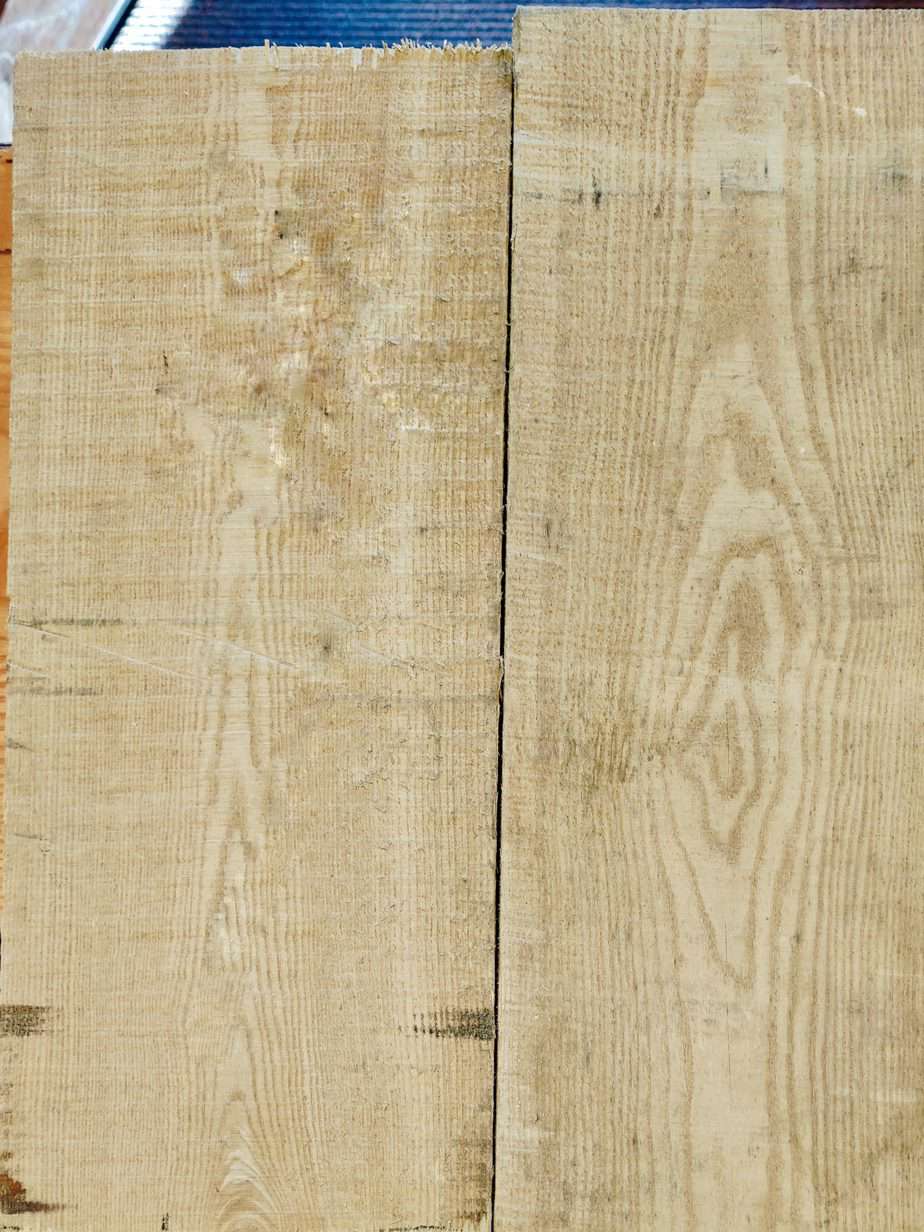Sassafras Lumber 8/4: What is it?
Sassafras is a hardwood lumber native to the eastern United States. Sassafras albidum has a pleasant aroma and ash-like appearance.
While not harvested on the same scale as oak, maple and poplar, it is a domestically produced hardwood.
Additionally it is relatively rot-resistant, durable and easy to machine. Probably, its most unique feature is its scent which is unlike any other wood I’ve experienced.
Buying Sassafras Lumber
Sassafras lumber 8/4 thickness is in the inventory of only a few niche lumber companies. It is relatively inexpensive compared to oak and ash. Typically sawmills grade it by NHLA lumber standards.
Many lumber companies do not carry it due to lower customer demand than other commercially sawn hardwoods like oak, maple, ash and cherry.
With 20+ years of hardwood lumber buying experience, I often find Sasssafras lumber difficult to source. However, this is not due to sustainability. Rather, it is not harvested commercially in large volumes.
We chose to include 4/4, 5/4 & 8/4 Sassafras in our lumber inventory due to ash shortages. Thus, Commercial Forest Products is a reliable source for Sassafras wood.
Does Sassafras Wood Make Good Lumber?
Sassafras wood makes good lumber for many woodworking applications. Of course, 4/4 is the most common thickness. However, 8/4 Sassafras lumber is used in luthiery and guitar building.
Due to its light weight and moisture resistance, it’s often used for boat building, fence posts and barrel staves. Additionally, its pleasing aroma adds a fragrant element to wood projects, similar to cedar or white oak.
Lumber Appearance
Not surprisingly its heartwood is light brown and looks like ash. In fact, many woodworkers use it as an ash substitute. Its sapwood is off-white/pale. Additionally, it has a pleasing scent similar to cedar.
Like Paulownia, Sassafras lumber is a low density lightweight hardwood. Additionally, its course grain and soft density makes it ideal for these woodworking applications:
- Millwork
- Instruments
- Cabinets
- Furniture
- Windows
- Doors
- Boats
- Fencing
Sassafras Lumber: Technical Information
Scientific name: Sassafras albidum
Alternative Names: Sassafrass, Saxifras, Cinnamon Wood, Saloop, Ague
Region of Origin: Appalachian United States, Northern United States,
Average Dried Weight: 32 LB/cubic foot
Janka Hardness Rating: 635
Specific Gravity: .50
IUCN Red List: No
CITES wood: No
Is Sassafras Wood Toxic?
The United Stated Food and Drug Administration considers Sassafras unsafe for human consumption.
Despite its use for medicinal purposes by Native Americans and early American settlers, excessive consumption causes increased cancer rates in lab rats.
As a lumber industry professional with over two decades of experience, I strongly encourage woodworkers not to eat Sassafras wood. Rather, they should make it into furniture, millwork, etc. It is a much better idea.

Sassafras Wood and Trees: Historical Uses
Interestingly, its historical uses are better known than its modern woodworking applications.
For example, in the summer of 2018, I toured the Strawbery Banke Museum in Portsmouth, New Hampshire. In the colonial woodworking exhibit, I tasted a sassafras twig. Signofocatly, the flavor was similar to root beer.
If want to read how the plant is used to make root beer, check out this recipe.
Sassafras is one of those trees surrounded by legend and lore. It is widely prized for its durability, making it a good choice for fencing and cooperage, as well as for boat building and canoes. But its real claim to fame might be a result of its storied byproducts, not the commercial timber uses. Native Americans and early settlers considered sassafras to be a cure all for all sorts of ailments.
The wood, which continues to be used in furniture, was often used in flooring and bedsteads because people believed the sassafras fragrance would drive away bedbugs and other pesky insects. Early settlers also believed that beds made from sassafras would drive away evil spirits and give people restful sleep.
source: Sassafras (Woodworking Network)
Sassafras Lumber in Guitar Building and Luthiery
Not surprisingly, its similarity to Ash makes it a Swamp Ash substitute. Additionally, the recent punky ash shortages forced guitar builders to look harder at alternate woods.
However, one of the largest electric guitar builders in the world, Fender, inadvertently used sassafras lumber early on. Accordingly, it is the inspiration for a recent historical release by famed Master Builder Michael Stevens.
The inspiration for Michael Stevens’ Founders Design Esquire stems from his vintage roots at Guitar Resurrection, where he and Larry Jameson loved blonde ash Stratocasters with gold hardware; they called these instruments Mary Kayes. “Some sassafras slipped into the run of ’54 Strats, early ’54s, that many people, for years, have been trying to figure out what it was,” he said. It is Stevens’ belief that it was quartersawn, one-piece sassafras.
So, instead of ash, the Founders Design Esquire is one-piece sassafras. A first glance, the front is classic Fender, with the control cavity switched backward. However, Stevens insists that players will discover other custom features once they pick up the guitar and take a closer look. Under the bridge cover is a pickup in a left-handed bridge – reversing the traditional Telecaster orientation – and when the guitar is turned over, there’s a cutaway for the player’s wrist and thigh, adding comfort in the sitting position. “A lot of it is ergonomic,” he said. “My thing, my style, pretty much is form follows function. Bauhaus. I love those guys.”
source: Founders Project Celebrates 30 Years of the Custom Shop (Fender)
Sassafras Guitar Body From Fender
See an early 1954 Sassafrass body wood Fender Stratocaster made by Tadeo Gomez here.
Fender’s Executive Vice President Justin Norvell, recently explained their logic to Guitar World:
“Sassafras is another, we just did an Eric Johnson sassafras Strat, which was based on his real one from the 50s. Again, Leo Fender was a pragmatist, he would have said, ‘What have you got today?’ They both have a similar grain pattern to ash and are sonically similar.
source: Fender will no longer use ash bodies for production-line guitars – we found out why, and what woods will be used instead (Guitar World)
Daemon Sassefrax
One of the most detailed on-line profiles of a Sassafras guitar is the Daemon Sassefrax by artist, sculptor & builder William Jeffrey Jones. Jones’s website shows many detailed pictures. The oil-finished grain is eerily similar to ash. The finished lightweight solid body guitar weighs an impressive 5 LB 12 oz.


Pingback: 🌳 Swamp Ash Wood Definitive Guide - Commercial Forest Products 2020
Pingback: Paulownia - Lumber -Wood - Commercial Forest Products - 2019 - 🌳